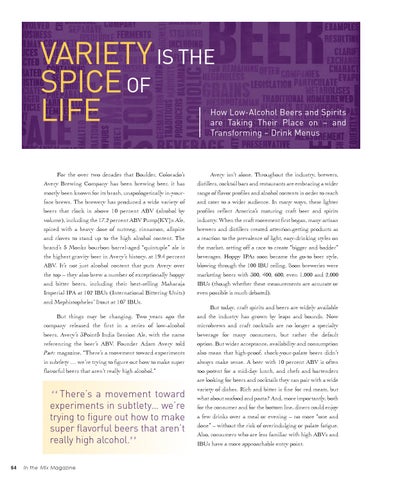VARIETY IS THE SPICE OF LIFE
How Low-Alcohol Beers and Spirits are Taking Their Place on – and Transforming – Drink Menus
For the over two decades that Boulder, Colorado’s Avery Brewing Company has been brewing beer, it has mostly been known for its brash, unapologetically in-yourface brews. The brewery has produced a wide variety of beers that clock in above 10 percent ABV (alcohol by volume), including the 17.2 percent ABV Pump[KY]n Ale, spiced with a heavy dose of nutmeg, cinnamon, allspice and cloves to stand up to the high alcohol content. The brand’s 5 Monks bourbon barrel-aged “quintuple” ale is the highest gravity beer in Avery’s history, at 19.4 percent ABV. It’s not just alcohol content that puts Avery over the top – they also brew a number of exceptionally hoppy and bitter beers, including their best-selling Maharaja Imperial IPA at 102 IBUs (International Bittering Units) and Mephistopheles’ Stout at 107 IBUs. But things may be changing. Two years ago the company released the first in a series of low-alcohol beers, Avery’s 3Point5 India Session Ale, with the name referencing the beer’s ABV. Founder Adam Avery told Paste magazine, “There’s a movement toward experiments in subtlety … we’re trying to figure out how to make super flavorful beers that aren’t really high alcohol.”
64
“
There’s a movement toward experiments in subtlety… we’re trying to figure out how to make super flavorful beers that aren’t really high alcohol.
in the Mix Magazine
”
Avery isn’t alone. Throughout the industry, brewers, distillers, cocktail bars and restaurants are embracing a wider range of flavor profiles and alcohol contents in order to reach and cater to a wider audience. In many ways, these lighter profiles reflect America’s maturing craft beer and spirits industry. When the craft movement first began, many artisan brewers and distillers created attention-getting products as a reaction to the prevalence of light, easy-drinking styles on the market, setting off a race to create “bigger and badder” beverages. Hoppy IPAs soon became the go-to beer style, blowing through the 100 IBU ceiling. Soon breweries were marketing beers with 300, 400, 600, even 1,000 and 2,000 IBUs (though whether these measurements are accurate or even possible is much debated). But today, craft spirits and beers are widely available and the industry has grown by leaps and bounds. Now microbrews and craft cocktails are no longer a specialty beverage for many consumers, but rather the default option. But wider acceptance, availability and consumption also mean that high-proof, shock-your-palate beers didn’t always make sense. A beer with 10 percent ABV is often too potent for a mid-day lunch, and chefs and bartenders are looking for beers and cocktails they can pair with a wide variety of dishes. Rich and bitter is fine for red meats, but what about seafood and pasta? And, more importantly, both for the consumer and for the bottom line, diners could enjoy a few drinks over a meal or evening – no more “one and done” – without the risk of overindulging or palate fatigue. Also, consumers who are less familiar with high ABVs and IBUs have a more approachable entry point.
